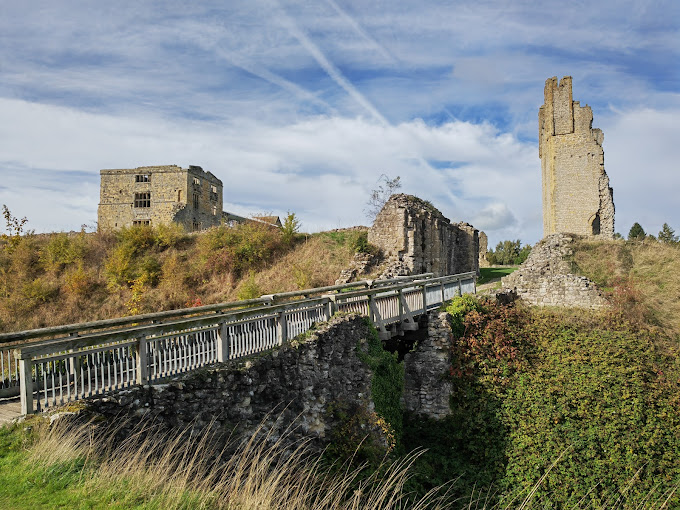Some places wear their history lightly. Helmsley Castle does not.
It looms.
Perched on a limestone ridge above the Rye Valley, it stands half-ruined, half-stubborn, as if still waiting for its next battle. It’s been everything—a Norman fortress, a grand Tudor home, a Civil War stronghold. And today? A perfect excuse for a walk, a bit of history, and, inevitably, tea and cake.
Patricia and I had been meaning to revisit Helmsley for a while. We’d been talking about castles recently—probably because I’d made the mistake of casually looking up how much it would cost to buy one in Spain. (Too much. And, as Patricia pointed out, I’d only end up falling down the spiral staircase.)
So, off to Helmsley we went.
Bertie, Latin, and the Spanish Debate
Before we’d even made it through the entrance, Bertie caused trouble.
Patricia, firm in her belief that small dogs are exempt from rules, attempted to take him into the gift shop. This lasted approximately ten seconds, at which point he wagged his tail so enthusiastically that an entire rack of postcards was sent flying. The woman behind the counter gave us a look.
Patricia scooped him up, muttering something about “cultural enrichment” for dogs. I pretended not to know either of them.
Once inside the castle walls, the first thing that strikes you is how much of it still stands. Unlike some of Yorkshire’s more dramatically ruined sites, Helmsley is half-intact, half-destroyed. One side still has towering walls and grand Tudor windows. The other? A jagged ruin, ripped open by the Parliamentarians during the Civil War.
You stand in the courtyard and can almost feel the different ages rubbing up against each other. Medieval power. Tudor refinement. Civil War devastation. All in one place.
Patricia, as always, read every single interpretation panel. I, as always, got distracted.
“Do you think I could climb that bit?” I asked, eyeing a particularly tempting section of wall.
The answer, it turns out, was no. The English Heritage staff member who caught me looking had the weary expression of someone who has stopped far too many middle-aged men from making bad decisions. I nodded, shuffling away like a schoolboy who’d been told off for swinging on his chair.
Near the remains of the hall, we found an old Latin inscription carved into the stone. Patricia, ever the history teacher, paused to examine it.
“This is why we should learn Spanish properly,” she said, out of nowhere.
I frowned. “That’s Latin.”
“Yes, but it’s the principle of the thing.”
This is a conversation we’ve been having for months. Every time we go back to our house in Galicia, we promise to improve our Spanish. And every time, we fail.
The problem? Nowhere nearby offers decent lessons. So, we’ve been talking about spending a month somewhere that does.
I’ve been looking at Speakeasy BCN‘s Spanish courses in Barcelona—they use history and culture as a teaching medium. You learn about the country, then actually go and see the sites. Perfect, right? A bit of immersive history?
Patricia disagrees. She wants Granada. Something about the Andalusian accent being “more lyrical.” I suspect this is just an excuse for her to sit in courtyards under orange trees while I struggle with verb conjugations.
It’s an ongoing discussion.
The Siege, the Pigeon, and the Victoria Sponge
Back in the 17th century, Helmsley Castle saw its final battle. During the Civil War, it was held by the Royalists for three months before finally surrendering to the Parliamentarians. When they took it, they made sure it could never be used defensively again.
They blew a massive hole in it.
It’s oddly beautiful, the way the broken walls frame the sky. You stand there and try to imagine what it must have been like—soldiers inside, waiting, listening, as cannons pounded the stone.
Bertie, meanwhile, was having his own battle. With a pigeon.
He stood in the middle of the courtyard, barking furiously, as the pigeon sat smugly on a ledge, just out of reach. People were starting to stare.
Patricia sighed. “This is why he’s not allowed in historic sites.”
History done, we wandered back into town and found a tea shop. Because no trip to a Yorkshire castle is complete without tea and cake.
Over a slice of Victoria sponge, we debated our Spanish school plans once more. I championed Barcelona. Patricia waxed lyrical about Granada. Bertie, exhausted from his battle with the pigeon, snored under the table.
Helmsley Castle, meanwhile, stood quietly in the distance, its ruins watching over the town. It has seen centuries of change—Normans, Tudors, sieges, destruction.
And now, two over-caffeinated retirees arguing about Spanish grammar.
History marches on.
